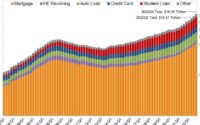Wall Street Fear Gauge Ratchets Up After Jobs Data: Markets Wrap
(Bloomberg) — Stocks sank while Treasury yields hit new multi-year highs after jobs data bolstered the case for the Federal Reserve to keep interest rates elevated.
Most Read from Bloomberg
The S&P 500 fell 1.4% to a four-month low while the Nasdaq 100 index dropped 1.8% after job openings unexpectedly increased in August. A House vote oustering Speaker Kevin McCarthy could further fuel uncertainty tomorrow. Wall Street’s fear gauge, the CBOE Volatility Index or VIX, rose above 20 intraday — a key level signaling increased skittishness in the market — the highest such reading since May. The ICE BofA MOVE Index, which tracks expected bond volatility, also approached May peaks.
Among Tuesday’s biggest losers were travel names including Airbnb Inc. and cruise ship operator Carnival Corp. while McCormick & Co. slid after the spice distributor’s sales missed estimates, hurt by a slow economic recovery in China. Intel Corp. jumped 2.6% in afterhours trading on plans to separate out its programmable chip division.
Markets tumbled across the board after the number of available positions rose to 9.61 million from less than 9 million in July, according to the Bureau of Labor Statistics’ Job Openings and Labor Turnover Survey, or JOLTS. The report drove swaps traders to increase wagers on the Federal Reserve raising rates in December to better than a 50-50 odds.
Read more: US Job Openings Top All Forecasts as White-Collar Positions Jump
Investors have yet to fully embrace the Fed’s higher-for-longer narrative and are instead following “fickle market momentum,” according to Luke Templeman, an analyst at Deutsche Bank. “Small catalysts are causing an outsized number to attempt to preempt market moves.”
“The dominant market theme, therefore, is one that many developed-market investors have not had to deal with since the ‘08-’09 crisis: volatility,” he added.
The next datapoint for the labor market will be a monthly payrolls print on Friday where traders will looking for any signs of cooling.
“Unless, the NFP report comes in lower than expected, Wall Street will likely start to fully price in at least one more Fed rate hike before the end of the year,” said Ed Moya, senior market analyst for the Americas at Oanda.
Yields on the US 10- and 30-year traded to the highest level since 2007, with the longer-term bond reaching above 4.9%. Wall Street has been speculating that rates on longer dated bonds will hit 5%. The climb in yields was also stoking anxiety in the credit market where at least two issuers called off sales Tuesday.
Read more: Credit Markets Wobble as Fed Speak, Data Fan Rate-Hike Angst
“The strength of the headline is impressive and certainly bodes well for the ongoing strength in the US labor market,“ Ian Lyngen, head of US rates strategy at BMO Capital Markets, wrote. While the JOLTs numbers are from August, “investors are nonetheless interpreting this as yet further confirmation that the US economy can withstand higher real borrowing costs.”
Wall Street strategists are warning about the impact that elevated interest rates have on equities, with Goldman Sachs Group Inc., Morgan Stanley and JPMorgan Chase & Co. saying there’s a risk of further stock-market declines.
This week’s Treasury selloff came after US lawmakers managed to avert a government shutdown, prompting traders to increase bets that the Fed will raise rates this year. Atlanta Fed President Raphael Bostic beat the “higher-for-longer” drum Tuesday saying the central bank needed to keep rates elevated “for a long time.” He forecast a single rate cut for 2024, toward the end of the year.
Comments from other Fed policymakers were more hawkish, with Cleveland Fed president Loretta Mester saying on Monday that one more rate hike was likely needed and Governor Michelle Bowman urging multiple increases.
West Texas Intermediate crude recovered from an early drop to head back toward $90 a barrel while the dollar index reached a 10-month high. The rally in the greenback drove the yen to its weakest level in a year as the Japanese currency touched 150 per dollar before reversing.
Key events this week:
-
China has week-long holiday
-
New Zealand rate decision, Wednesday
-
Eurozone services and composite PMIs, Wednesday
-
ECB President Christine Lagarde gives welcome address at conference, Wednesday
-
US ISM services index, Wednesday
-
France industrial production, Thursday
-
BOE Deputy Governor Ben Broadbent, Riksbank First Deputy Governor Anna Breman participate at panel discussion, Thursday
-
US trade, initial jobless claims, Thursday
-
San Francisco Fed President Mary Daly speaks at the Economic Club of New York, Thursday
-
Germany factory orders, Friday
-
US unemployment rate, nonfarm payrolls, Friday
Some of the main moves in markets:
Stocks
-
The S&P 500 fell 1.4% as of 4 p.m. New York time
-
The Nasdaq 100 fell 1.8%
-
The Dow Jones Industrial Average fell 1.3%
-
The MSCI World index fell 1.4%
Currencies
-
The Bloomberg Dollar Spot Index rose 0.2%
-
The euro was little changed at $1.0471
-
The British pound was little changed at $1.2078
-
The Japanese yen rose 0.7% to 148.77 per dollar
Cryptocurrencies
-
Bitcoin fell 2% to $27,278
-
Ether fell 0.9% to $1,650.68
Bonds
-
The yield on 10-year Treasuries advanced 12 basis points to 4.80%
-
Germany’s 10-year yield advanced five basis points to 2.97%
-
Britain’s 10-year yield advanced three basis points to 4.60%
Commodities
-
West Texas Intermediate crude rose 0.8% to $89.56 a barrel
-
Gold futures fell 0.4% to $1,840.10 an ounce
This story was produced with the assistance of Bloomberg Automation.
–With assistance from Edward Bolingbroke, Sujata Rao, Julien Ponthus, Jason Scott and Tassia Sipahutar.
Most Read from Bloomberg Businessweek
©2023 Bloomberg L.P.
[ad_2]
Source link


